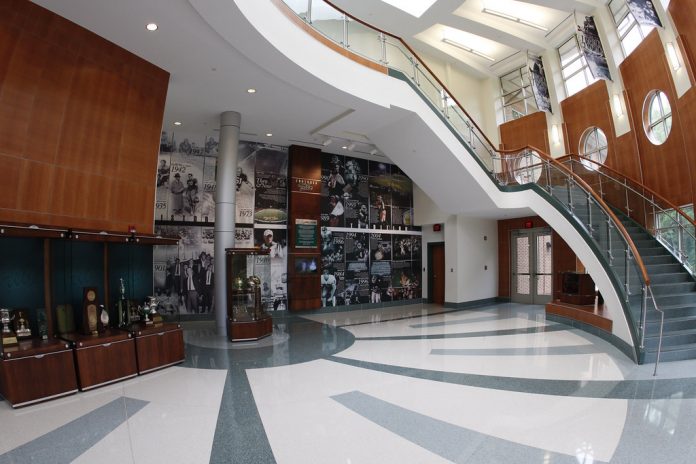William and Mary should take a mulligan. Reinstate the four male athletic programs and put a plan in place to add two women’s sports: softball and rowing. These decisions would solve many of William and Mary Athletics’ systemic problems by strengthening Title IX compliance, increasing the donor pool, and increasing competitive success. William and Mary must always keep the focus on individuals when making decisions. We are One Tribe for a reason. Our student athletes are more than that. They are scholar athletes. Increasing the number of the highest-quality scholars should be the top priority of the college. If a varsity sport is not offered, then the college cannot even compete for those scholars.
Much of the leadership and character building that makes student athletes so successful in life comes from the adversity unique to varsity athletics. Adversity builds leaders. I see it every day as an Army officer. Club sports are simply not the same developmental experience.
Increasing the number of athletic opportunities is financially advantageous because varsity athletic alumni are shown to donate far more than their peers. The 2015 athletic report states that William and Mary’s athletic alumni were 50 percent more likely to donate and that their gifts were 45 percent larger; they are 12 percent of alumni, but contribute 29 percent of undergraduate gifts. It also points out that 96 percent of senior women executives in America were student athletes. The 2006 report states that the participation rate for athletic alumni was 50 percent, compared to only 23 percent for their peers. The 2018 report stated that in 2016-17, 33 percent of student athletes gave to athletics and the amount of giving increased by 23 percent over the decade.
Almost half of their donations are going to non-athletic causes. Eliminating 15 percent of all future giving opportunities seems shortsighted, particularly given that those teams represent less than 10 percent of annual expenses. This decision may have a chilling effect on giving. As someone who has established an endowed scholarship for a surviving sport, I am apprehensive about making additional contributions to it.
I have made a paradigm shift on my definition of competitive success. When I watched my niece and nephew play Division 1 Softball and Baseball, I saw winning as the only measure of success. The cancellation of my nephew’s baseball season last spring from COVID-19 has changed my view of what is competitive success. How can you win if there is no team to compete on? William and Mary Athletics is competitively successful if measured both quantitatively (number of athletes) and qualitatively (wins). William and Mary has always chosen to emphasize the quantitative approach because that is who we are. One Tribe.
In a conversation I had with athletic director John Randolph for the 1993 task force on student athletic fees, he lamented the fact that he could not fill the Hall for basketball. He was convinced it would solve all his funding issues. William and Mary has been throwing money at this problem since Kaplan Arena opened 50 years ago. It needs to be bold and change playbooks.
Do not use Title IX as the reason for eliminating 81 male athletes’ opportunities in 2021. The Women’s Sports Foundation reports that only five percent of colleges currently offer athletic opportunities that are proportionate to their student population. When I co-chaired the task force in 1992-93, I worked with this organization to understand Title IX. That report strongly recommended increasing women’s opportunities. This is a critical problem to solve after the pandemic is over. But do not use it as the reason to eliminate programs now. I am certain the women athletes do not want their male colleagues to lose their opportunities this way.
The long-term solution to Title IX issues is to increase the number of women’s sports. The average number of roster slots for women’s rowing is 47 and it is allocated 20 scholarships by the NCAA. Softball has 25 roster spots and 12 scholarships. Ensure proportionality in scholarship funds within two years and then resolve the overall proportionality issue on a defined time line.William and Mary uses the same old playbook to cut men’s Olympic sports while it protects football. Football currently has 30 percent (102) of all male roster spots. The proposed 2021-22 participation roster gives football 47 percent (95) of male roster spots. It has 24 percent of the assistant coaches in the department. Women currently hold 54 percent of non-football roster spots. In 2021-22, that will rise to 66 percent. Although I do not favor it, eliminating the football program would substantially solve the Title IX and financial problems.
The Title IX and financial problems must be solved together. President Kennedy said “a rising tide raises all boats.” Every athletic program needs to be on deck to succeed. Start by reinstating the four men’s programs to rebuild trust with donors. Tighten the operating belt across the board. Temporarily lower the number of assistant coaches or require some to coach an additional sport. Temporarily reduce the number of roster spots on all male sports. Set aggressive fundraising targets for every sport to meet annually, based on the average of that program’s last five years of donations. Targets would be percentage based, so a 10 percent increase would be different dollar amount for each team. This will grow the donor base for all programs. Donors would indicate what sport they want their donation credited to if it goes to a non-specific athletic fund, such as the Tribe Club. Create a new Title IX fund that would be used to establish the new women’s programs. Assess each program’s donations annually, including its contributions to the Title IX fund. Reward or penalize a program for exceeding or missing its target. Thus, every program is in the tide and has the same challenges, the same consequences, and the same incentives to raise the tide together. One Tribe!
.
Brad Davis ‘91, MAEd. ‘93

